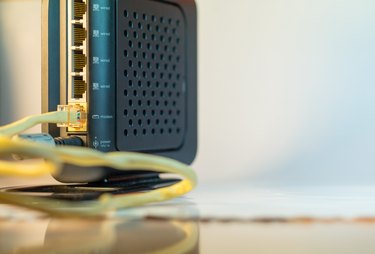
When your Motorola Surfboard modem loses connection, checking your cables and restarting your modem is generally the best way to address the problem. It also helps to understand what the signal lights mean so that you can identify what's wrong if you see an issue like a Motorola Surfboard SB6141 blinking blue light. While these simple steps won't fix every error – in many cases, you'll need to contact your ISP – they can restore connectivity in many cases.
Check the Signal Lights
Video of the Day
During normal operation, all the display lights on your modem remain solidly lit. If any of the lights are out or you notice a Motorola Surfboard flashing blue link light, this indicates there's a problem with your connection. If you do have to contact your ISP, make a note of which lights are on and which lights are off, as this information is helpful in diagnosing the problem.
Video of the Day
- If the power light is off or blinking, there's a problem with the modem's power supply.
- If the receiving light is off or blinking, your modem isn't receiving data properly.
- If the sending light is off or blinking, your modem isn't sending data properly.
- If the online status light is off or blinking, your modem is connected but something is preventing online access.
- If the PC/Activity light is off or blinking, there may be a problem with the connection between your computer and the modem.
Check the Cable Connections
A loose or disconnected cable in any number of places can cause your modem to stop working properly. Start by checking the power cable and making sure it's securely connected to both the power outlet and your modem. Then, check the coaxial cable connected to your modem.
If your computer is connected directly to the modem using an Ethernet cable, check to make sure the cable is secure. If it's connected using a router, check the Ethernet cable connecting the router to the modem, as well as the cable connecting the computer to the router.
Power Cycle Modem and Devices
If all the connections are secure, you may need to power cycle your modem and connected devices to restore connectivity. To power-cycle everything properly, you need to work outside-in, starting with powering down devices connected to the modem and the the modem itself, then powering them back up in reverse order. The following steps are an example of how to do so, but if you have additional devices you may need to include them in the steps.
- Power down your computer and disconnect it from your modem or router.
- Switch off your router if you're using one, or disconnect its power source if it doesn't have a power switch.
- Switch off your modem, or if your modem doesn't feature a power switch, disconnect the power cable from your modem.
- Wait about 30 seconds, then reconnect the modem's power cable or switch the modem back on.
- Power up and reconnect your router.
- Start up your computer and reconnect it to your modem/router.
In addition to power cycling, you can use your modem's reset button. This button is very small and usually located on the back panel of the modem. It can only be pressed by using a long, thin object like a pen tip or a straightened-out paper clip. Press and hold the button for about five seconds to restart your modem.
Contact Your ISP
If your cables are all securely connected and the power-cycling devices hasn't foxed your problem, the glitch may lie with your cable provider. Contact your ISP and check to see if there's a problem with the service or with your account. If not, your ISP's technical support department should be able to diagnose the problem.